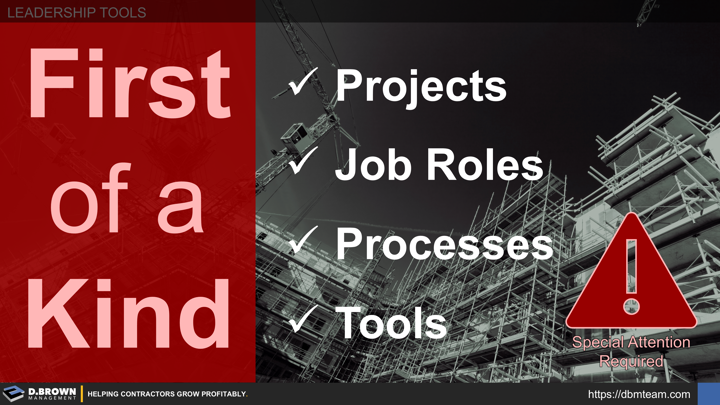Contractors face many "First-of-a-Kind" situations at each stage of growth, including:
- Projects involving new types, scopes, size ranges.
- Delivery methods—for example, transitioning from design-bid-build to alternative delivery methods like CM at risk.
- Customers, including different project teams within the same company if they operate differently.
- Geographies, which may introduce different building codes, suppliers, subcontractors, competition, labor laws, taxes, and other regulation.
- New job roles created as the company grows, often requiring three iterations to align everything.
- First succession into an existing job role, with the riskiest being the first-time ownership succession.
- New equipment and technology that significantly alter workflow.
Four Quick Steps to Manage First-of-a-Kind Effectively
The first step is just being aware of what qualifies as First-of-a-Kind.
The second step is understanding the perspective of those who will be directly responsible for and interacting with whatever is new. It is very likely that the person making the decision to take on something new has a significantly different ability to identify and solve problems in First-of-a-Kind situations than the people who will actually be identifying and solving those problems.
The third step is to allocate excess resources, including measurements systems, around the First-of-a-Kind. The risks mitigated will more than compensate for the extra resources invested. More importantly, these additional resources and measurements will help develop the right standards and training, allowing you to move from First-of-a-Kind to consistently repeatable much quicker.
The fourth step is to remove unnecessary levels of resources and controls as you transition from First-of-a-Kind to routine execution. Otherwise, you risk creating stifling bureaucracy.
Remember that many of the reasons Thomas C. Schleifer identified in Construction Contractor's Survival Guide had their root cause in First-of-a-Kind circumstances.
Don't take on more First-of-a-Kind changes than you can effectively resource.

